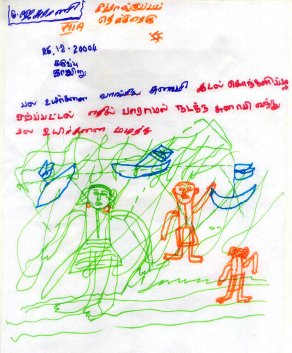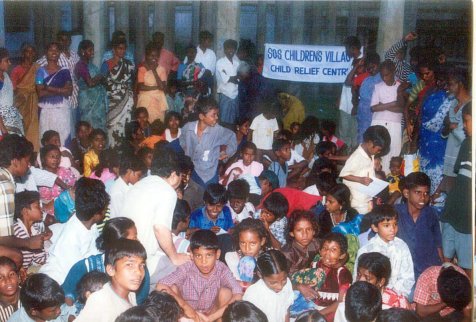Disaster Relief: Indian Ocean
03/01/2005

TSUNAMI DISASTER
We have enough sponsors for tsunami orphans. PLease sponsor an African AIDS orphan instead. On 26th December, a massive underwater earthquake sent devastating giant waves into coastlines across the Indian Ocean. Such earthquakes suddenly change the height of the sea floor by up to several metres and as a result hundreds of miles of ocean can find itself above sea level. As a result the water stranded too high pours faster and faster into the surrounding sea giving massive wave flow called tsunami or tidal waves which have many miles of water in thickness and travel very fast.
As of today (3 Jan 2005), it is estimated that 150,000 lives have been lost to the massive tsunami and many more victims are still unaccounted for.
All 48 SOS Children’s Communities in India, Sri Lanka, Thailand and Indonesia, are thankfully all undamaged; some by incredible chance - but we have infrastructure and people there on the ground and obviously will play a central role in helping people especially children around us. We are launching this emergency appeal for funds to help us help the local devasted population. SOS Children has been working in South East Asia since 1963. In a region where there are 42,840,000 recorded orphans the impact of the tsunami on an already vulnerable population is unimaginable.
Teams of relief workers from SOS Children in India and Sri Lanka are on the ground in badly-hit areas to assess the need and to co-ordinate relief operations. They are working on India’s and Sri Lanka’s East coast where thousands - among them many children - have been left dead, thousands are missing and possibly millions have become homeless.
SOS Children in India

See SOS in India for background to our India operations. SOS Children’s teams of relief workers are organising the setting up of 16 emergency relief camps in the South of India. According to our head of operations, Victor Painadath, there are 30,000 children in the region in urgent need of help.
This is how Victor describes the disaster situation in the town Nagappattinam:
“It’s been 48 hours now since the tsunami (tidal wave) hit this town. The roads are full of mud and dirt as the sea water has recessed. There is debris of broken walls, boats, shoes and other debris. The place has the pungent smell of dead bodies. The main activity here is cleaning up the whole place. Shops are closed and life is at a stand still. We saw a hundred people running, shouting that the waters are coming again. I saw women crying out in panic, trembling children running to their mothers. There was nothing there, except someone having watched high waves hitting the shores. I explain this to you to show you that people here are living in terrible fear.” Victor Painadath, Head of Operations, Tsunami Emergency Relief Programme, India.
In the towns of Velakanni, Nagappattinam and Kanykumari and neighbouring communities, between 3,000 and 4,000 children will be provided with food, clothes and medical care; through daily games and activities, they will have the opportunity to process the traumatic experiences of loss, being scared and witnessing destruction.
The temples in these towns have provided vulnerable families with a place of refuge and SOS Children will set up camps inside the temple buildings and in the grounds of the temples to provide these families with food, clean drinking water, clothes and medication.
In the fishing village of Cuddalore in the Pondicherry province, hundreds of men who were out fishing when the tsunami struck have not returned. The families in this small village have lost everything - their houses, their boats and fishing nets, their livelihoods. SOS Children’s Villages is currently establishing temporary shelters for these families.
The coming weeks will tell how many children have lost their parents and relatives in the disaster and therefore how many will need long term care in SOS Children’s Villages.
SOS Children in Sri Lanka
The main task of the aid and emergency work in Sri Lanka is to provide assistance to the hard hit disaster areas on the south coast. At the same time - many of the worst hit communities in East Sri Lanka cannot be reached as some areas are still under the control of the LTTE (Liberation Tigers of Talim Eelam).
Yesterday SOS Children was successful in delivering our first batch of relief supplies for 3,000 children to the SOS Social Centre Batticaloa on the east coast.
Many of the people hit by the tsunami disaster were made homeless just a month ago by the November flood disaster. Entire families have now been lost. The buildings of the SOS Children Social Centre in Batticaloa on the east coast are now emergency shelters for people who have survived but who have lost everything. A lorry loaded with relief packages for 3,000 homeless children arrived yesterday with clean drinking water, food, dairy products for small children, candles, matches and clothes.
SOS Children is already planning ways to work with the community in the long term to help rebuild their livelihoods.
In Piliyandala where the first SOS Children’s Village was built in Sri Lanka, more than 500 families have found refuge in the main temple compound near the capital city of Colombo. SOS Children is organising medical care and food for these families in co-operation with temple authorities.